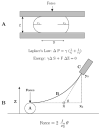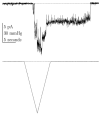Mechanosensitive ion channels and the peptide inhibitor GsMTx-4: history, properties, mechanisms and pharmacology
- PMID: 17157345
- PMCID: PMC1852511
- DOI: 10.1016/j.toxicon.2006.09.030
Mechanosensitive ion channels and the peptide inhibitor GsMTx-4: history, properties, mechanisms and pharmacology
Abstract
Sensing the energy from mechanical inputs is ubiquitous--and perhaps the oldest form of biological energy transduction. However, the tools available to probe the mechanisms of transduction are far fewer than for the chemical and electric field sensitive transducers. The one pharmacological tool available for mechansensitive ion channels (MSCs) is a peptide (GsMTx-4) isolated from venom of the tarantula, Grammostola spatulata, that blocks cationic MSCs found in non-specialized eukaryotic tissues. In this review, we summarize the current knowledge of GsMTx-4, and discuss the inevitable crosstalk between the MSC behavior and the mechanical properties of the cell cortex.
Figures


















References
-
- Andersen OS, Nielsen C, Maer AM, Lundbæk JA, Goulian M, Koeppe RE. Ion channels as tools to monitor lipid bilayer-membrane protein interactions: gramicidin channels as molecular force transducers. Methods Enzymol. 1999;294:208–224. - PubMed
-
- Araque A, Carmignoto G, Haydon PG. Dynamic signaling between astrocytes and neurons. Annu Rev Physiol. 2001;63:795–813. - PubMed
-
- Arnon A, Hamlyn JM, Blaustein MP. Na+ entry via store-operated channels modulates Ca2+ signaling in arterial myocytes. American Journal Of Physiology-Cell Physiology. 2000;278:C163–C173. - PubMed
-
- Bass RB, Locher KP, Borths E, Poon Y, Strop P, Lee A, Rees DC. The structures of BtuCD and MscS and their implications for transporter and channel function. FEBS Lett. 2003;555:111–115. - PubMed
Publication types
MeSH terms
Substances
Grants and funding
LinkOut - more resources
Full Text Sources
Other Literature Sources

